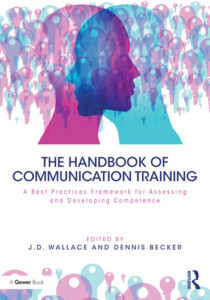Have questions about a blog post? Email the author directly. We love hearing from people.
11 Jan Choosing a High Quality Speech Coach
 If you are looking for a communication coach to help you with your effectiveness as a communicator, I urge you to check out the new book published by Rutledge. It’s called The Handbook of Communication Training. It features 50 different communication professionals, experts, professors, and practitioners from around the United States who have come together to agree that the best communication coaching and learning happens when your coach has been trained and shows prowess in these seven best practices. They are: (more…)
If you are looking for a communication coach to help you with your effectiveness as a communicator, I urge you to check out the new book published by Rutledge. It’s called The Handbook of Communication Training. It features 50 different communication professionals, experts, professors, and practitioners from around the United States who have come together to agree that the best communication coaching and learning happens when your coach has been trained and shows prowess in these seven best practices. They are: (more…)
15 Dec Can You Learn Presentation and Public Speaking Skills in an Online Course?
 Clients often tell us about an online course they found, or their company has provided, on Public Speaking and Presentation Skills. Then, they ask us what we think of it.
Clients often tell us about an online course they found, or their company has provided, on Public Speaking and Presentation Skills. Then, they ask us what we think of it.
There are two primary considerations:
1. Yes, you can learn some communication skills alone and online.
2. The skills you need must be compatible with online learning.
Number two explains the potential challenges with learning communication skills online. (more…)
26 Nov Why Doesn’t a Power Pose Work for Me?
 Dating back as far as the 1950s, psychologists have connected the idea of your physical position with confidence. For example, people associated the psychology of “walking tall” with confidence. Over the decades, the concept evolved. In addition, movies, television, and social media have projected what confidence looks like. So it’s not much of a surprise when language like “power pose” and “Wonderwoman pose “ have gained new attention to the idea that your physical stance can impact confidence. (more…)
Dating back as far as the 1950s, psychologists have connected the idea of your physical position with confidence. For example, people associated the psychology of “walking tall” with confidence. Over the decades, the concept evolved. In addition, movies, television, and social media have projected what confidence looks like. So it’s not much of a surprise when language like “power pose” and “Wonderwoman pose “ have gained new attention to the idea that your physical stance can impact confidence. (more…)
22 Nov Don’t Talk Too Much!
 If you are a person who tends to give others too much information or go down rabbit holes of multiple topics, you will benefit by mastering an awareness of how much content you can deliver in 60 seconds. In addition, organizing your thoughts and practicing the delivery as a Subject Matter Expert will help you engage your listeners and make a memorable impact. (more…)
If you are a person who tends to give others too much information or go down rabbit holes of multiple topics, you will benefit by mastering an awareness of how much content you can deliver in 60 seconds. In addition, organizing your thoughts and practicing the delivery as a Subject Matter Expert will help you engage your listeners and make a memorable impact. (more…)
8 Nov Managing Body Language in Difficult Communication Settings
 It is important to observe your listeners’ body language as a first step. Whether in the room with you or on video conference, your listeners may exhibit signs of stress because of a lack of clarity or contentious information. What does this look like? The listeners may engage in side conversations. There may be a rumbling in the audience. This tells you, the speaker, that you’ve done something to trigger this reaction and produce negative reactions. (more…)
It is important to observe your listeners’ body language as a first step. Whether in the room with you or on video conference, your listeners may exhibit signs of stress because of a lack of clarity or contentious information. What does this look like? The listeners may engage in side conversations. There may be a rumbling in the audience. This tells you, the speaker, that you’ve done something to trigger this reaction and produce negative reactions. (more…)
19 Oct Are you having conflict and disagreement at work?
 Are you having conflict and disagreement at work?
Are you having conflict and disagreement at work?
Then, follow the advice of the thought leader….and get off the keyboard!
A Japanese client from a well-known American-owned private equity firm in Tokyo recently worked on persuasion for my coaching efforts. We ended up analyzing a Ted Talk from Julia Dhar, a noted Australian speaker on debate, conflict, and persuasion. (more…)
7 Oct Calling all Wonder Women!
 As female leaders, we must stay current with strategies for communicating our confidence. So, here’s an exciting piece of research. As a Coach, I work with my clients to focus on the goal of speaking with confidence.
As female leaders, we must stay current with strategies for communicating our confidence. So, here’s an exciting piece of research. As a Coach, I work with my clients to focus on the goal of speaking with confidence.
The way we talk about our accomplishments can make or break us. So, here’s an interesting article to help keep perspective. The research focuses on identifying key female areas communicators can use to strengthen their effectiveness.
Be a business superhero in your skin and harness your tools speak with confidence.

 `
`
READ MORE
30 Sep Communication Style
 What impression do other people have of you? Have you ever focused on what and how you communicate with others? If asked to use two words to describe you, what would they say? For that matter, what would you say? Centuries ago, Sir Walter Raleigh wrote that communication needs to be “chameleon-like.” He was not talking about being something different with each person you meet. He was urging leaders of the time to be aware of their communication style. (more…)
What impression do other people have of you? Have you ever focused on what and how you communicate with others? If asked to use two words to describe you, what would they say? For that matter, what would you say? Centuries ago, Sir Walter Raleigh wrote that communication needs to be “chameleon-like.” He was not talking about being something different with each person you meet. He was urging leaders of the time to be aware of their communication style. (more…)
15 Sep Is It Possible to Over Prepare for a Presentation?
 When preparing a presentation, TED talk, webinar, investor pitch, wedding toast, or anything in between, there can be a struggle with how much to prepare in advance. (more…)
When preparing a presentation, TED talk, webinar, investor pitch, wedding toast, or anything in between, there can be a struggle with how much to prepare in advance. (more…)
